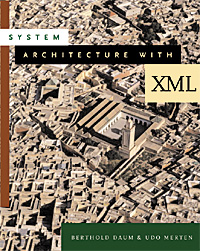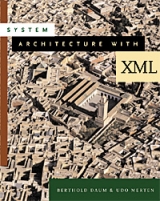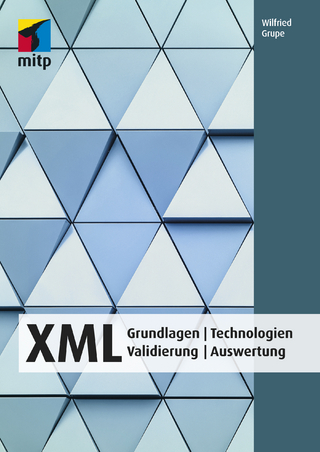XML is bringing together some fairly disparate groups into a new cultural
clash: document developers trying to understand what a transaction is,
database analysts getting upset because the relational model doesn't fit
anymore, and web designers having to deal with schemata and rule based
transformations. The key to rising above the confusion is to understand the
different semantic structures that lie beneath the standards of XML, and
how to model the semantics to achieve the goals of the organization.
A pure architecture of XML doesn't exist yet, and it may never exist as the
underlying technologies are so diverse. Still, the key to understanding how
to build the new web infrastructure for electronic business lies in
understanding the landscape of these new standards.
If your background is in document processing, this book will show how
you can use conceptual modeling to model business scenarios consisting of
business objects, relationships, processes, and transactions in a
document-centric way. Database designers will learn if XML is subject to
relational normalization and how this fits in with the hierarchical structure
of XML documents. Web designers will discover that XML puts them into
a position to automatically generate visually pleasing web pages and rich
multimedia shows from otherwise dry product catalogues by using XSLT
and other transformation tools. Business architects will see how XML can
help them to define applications that can be quickly adapted the ever
changing requirements of the market.
"System Architecture with XML covers today´s most important issues in XML
specifications and technology. It is a "must read" for architects who need to
integrate XML into their enterprise systems."
-- Tom Marrs, Senior J2EE/XML Architect, Distributed Computing Solutions, Inc.
XML is bringing together some fairly disparate groups into a new cultural clash: document developers trying to understand what a transaction is, database analysts getting upset because the relational model doesn't fit anymore, and web designers having to deal with schemata and rule based transformations. The key to rising above the confusion is to understand the different semantic structures that lie beneath the standards of XML, and how to model the semantics to achieve the goals of the organization.
A pure architecture of XML doesn't exist yet, and it may never exist as the underlying technologies are so diverse. Still, the key to understanding how to build the new web infrastructure for electronic business lies in understanding the landscape of these new standards.
If your background is in document processing, this book will show how you can use conceptual modeling to model business scenarios consisting of business objects, relationships, processes, and transactions in a document-centric way. Database designers will learn if XML is subject to relational normalization and how this fits in with the hierarchical structure of XML documents. Web designers will discover that XML puts them into a position to automatically generate visually pleasing web pages and rich multimedia shows from otherwise dry product catalogues by using XSLT and other transformation tools. Business architects will see how XML can help them to define applications that can be quickly adapted the ever changing requirements of the market.
Berthold Daum holds a Ph.D. in mathematics and was a codeveloper of NATURAL 4GL at Software AG. He has lectured in database design at the University of Karlsruhe and has practical experience in the design and implementation of large distributed online systems. In the 1980s, he became involved in artificial intelligence and was a member of the ISO standardization committee for PROLOG. He has published various articles in trade magazines and scientific publications, and is co-author with Udo Merten of System Architecture with XML , and author of the forthcoming Modeling Business Objects with XML Schema . Currently he runs a consulting agency for industrial communication.
Table of Content
Foreword vii
Preface xvii
Chapter 1 SCENARIO 1
1.1 Megapolis Internet 2
1.1.1 The Nonplanned Settlement 2
1.1.2 Topology—Transactional, Relational,
Navigational 4
1.1.3 Babel 6
1.1.4 Subcultures and Ontologies 7
1.1.5 Challenges 9
1.2 Implications 12
1.2.1 The Blurring of the Classical Application 12
1.2.2 Collaboration Instead of Integration 13
1.2.3 The Return of AI 13
1.2.4 Soft Logic 13
1.3 Architectural Patterns 14
1.3.1 Dwellings 15
1.3.2 Community Infrastructure 18
1.4 Best Practices 22
Chapter 2 GROUNDWORK 25
2.1 XML: A Language Factory 26
2.2 XML Basics 27
2.2.1 The Syntax 27
2.2.2 The XML Information Model 33
2.3 Schema Definition—Stage 1 34
2.3.1 The Document Type Definition (DTD) 35
2.3.2 Advanced Topics 38
2.4 Schema Definition—Stage 2 39
2.4.1 DTD Deficiencies 39
2.4.2 XML Schema 40
2.5 Access and Composition 53
2.5.1 Xpath 53
2.5.2 Xpointer 54
2.5.3 Xinclude 57
2.5.4 XML Base 58
2.6 Querying XML 59
2.6.1 Expression Types 60
2.6.2 Discussion 64
2.7 XSL (Extensible Stylesheet Language) 64
2.8 XML APIs 65
2.8.1 SAX 65
2.8.2 DOM 66
2.8.3 Binding 67
2.8.4 Which API? 67
2.9 Schema Definition—Stage 3 68
2.9.1 A Feather Duster for XML Schemata 68
2.9.2 Elements versus Attributes 70
2.9.3 XML Design Patterns 74
2.9.4 Architectural Forms 76
2.10 Best Practices 79
2.10.1 Always Use Namespaces 79
2.10.2 Do Not Reinvent the Wheel 79
2.10.3 Multipart Schemata? 80
2.10.4 Avoid External Entities 80
2.10.5 Never Change a Published Schema 80
2.10.6 Use Only Version-Controlled
Schemata 80
2.10.7 Consider Equipping Each Document
Element with a UUID Attribute 81
2.10.8 Adopt a Concise Style for Schema
Design 81
2.10.9 Do Not Use Exotic Language Elements 82
2.11 XML Resources 83
Chapter 3 STRUCTURE 85
3.1 The Evolution of Data Models 86
3.1.1 CODASYL 87
3.1.2 Hierarchical Databases 89
3.1.3 Relational Databases 89
3.1.4 Navigational Architectures 95
3.2 Conceptual Modeling 100
3.2.1 The Entity Relationship Model 101
3.2.2 Asset-Oriented Modeling (AOM) 108
3.2.3 A Document-Centered Step-by-Step
Approach 113
3.2.4 Smash the Enterprise Data Model? 132
3.2.5 Best Practices 133
3.3 The Resource Description Framework
and Conceptual Modeling 134
3.3.1 RDF Basics 135
3.3.2 From ERM to RDF 139
3.3.3 Advanced Modeling Techniques 143
3.3.4 Reification 150
3.3.5 RDF Schema 152
3.3.6 Reasoning with RDF 156
3.3.7 Best Practices 158
3.4 A U for an X 158
3.4.1 XML Modeling with UML 158
3.4.2 XMI: Exchange Format for Model Data 163
Chapter 4 MEANING 169
4.1 Formal Semantics 170
4.1.1 Formal Semantics and Constraints 171
4.1.2 Constraints in Schema Definitions 173
4.2 Ontologies 174
4.2.1 Ontological Depth 174
4.2.2 Operational Ontologies: DAML and OIL 180
4.2.3 Best Practices 183
4.3 Philosophical Excursus 184
4.4 Context 185
4.4.1 Ontologies and Contexts 186
4.4.2 Binding to Contexts: Schema Adjunct 189
Chapter 5 MODELING PROCESSES 193
5.1 Concepts of Business Process Modeling 194
5.1.1 Overview of Process Paradigms 194
5.1.2 Notion of Workflows and Modeling 195
5.1.3 Metamodeling Aspects 197
5.2 Business Process Modeling and
Systems Development 199
5.2.1 Background 199
5.2.2 What Is a Business Process? 201
5.2.3 Employing Formal Modeling 205
5.2.4 A Business-Centered Modeling
Approach 214
5.2.5 Process Design and Object Orientation 216
5.3 Communication and Cooperation:
Toward Agent-Based Systems 216
5.3.1 The Notion of Agent-Based Systems 217
5.3.2 Typology and Applications of Agents 218
5.3.3 Agent-Oriented Concepts 220
5.3.4 ADEPT 223
5.4 Process Concepts and XML 226
5.4.1 Actor-Driven Processes 226
5.4.2 Open Communication Processes 226
5.4.3 Contract-Based Interaction with tpaML 228
5.4.4 Self-Modifying Processes 229
5.4.5 The Business Process Management
Initiative (BPMI) 230
5.4.6 Business Rules 233
5.5 Concluding Remarks 238
Chapter 6 HISTORY 241
6.1 History 242
6.2 Layer of Communication 243
6.3 Channels and Ports 245
6.4 Speech Acts 246
6.5 Messages 248
6.5.1 Simple and Complex Messages 248
6.5.2 SOAP 249
6.5.3 XML Protocol (SOAP 1.2) 253
6.6 Transactions and Protocols 253
6.6.1 ACID Transactions 253
6.6.2 Transactional Web Services 254
6.6.3 The Web Services Description
Language (WSDL) 255
6.7 Semantics of Communication 259
6.7.l Content-Based Routing 259
6.7.2 Ontology Mapping 260
6.8 Security 260
6.8.1 Basics 261
6.8.2 XML Security 262
6.8.3 XML Signature 263
6.8.4 XML Encryption 265
Chapter 7 HYPERMEDIA 267
7.1 Hypermedia 268
7.1.1 A Short History of Hypermedia 268
7.1.2 Hypermedia Navigation 269
7.2 Topic Maps 283
7.2.1 A GPS for the Web 283
7.2.2 Another Philosophical Excursus 294
7.2.3 Topic Maps versus RDF 296
7.3 Directory Services (UDDI) 297
7.4 Peer-to-Peer Architectures 300
Chapter 8 PRESENTATION FORMATS 303
8.1 Presentation and Representation 304
8.1.1 Results from Multimedia Research 304
8.1.2 Dimensions of Multimedia Composition 307
8.1.3 The Advantage of Audiovisual
Information 309
8.1.4 Multimedia Data Models 310
8.2 Viewing XML Data on the Web 312
8.2.1 Overview of Viewing XML Data 313
8.2.2 HTML 315
8.2.3 XHTML 317
8.2.4 Formatting Objects with XSL 321
8.3 User Interaction with XForms 326
8.3.1 Concepts of Xforms 326
8.3.2 Implementations 329
8.4 Exchanging Information through WAP Devices 330
8.4.1 What Is WAP? 330
8.4.2 WML 332
8.4.3 WMLScript 333
8.4.4 WBXML 334
8.4.5 Links to WAP Tools 335
8.5 Graphical and Multimedia Presentation
with XML 336
8.5.1 SMIL 336
8.5.2 SVG 340
8.5.3 VoiceXML 342
8.6 Document-Based Type Setting 346
8.6.1 PDF 346
8.6.2 (La)TeX 347
Chapter 9 TRANSFORMATION 351
9.1 Procedural Transformation 352
9.2 Rule-Based Transformation 355
9.3 What XSLT Can Do 357
9.3.1 Variables 357
9.3.2 Keys 358
9.3.3 Multiple Input Files 358
9.3.4 Various Output Methods 358
9.3.5 Metatransformations 359
9.3.6 Modules 359
9.4 What XSLT Can’t Do 360
9.5 Extensions 360
9.6 Authoring and Testing of XSL Style Sheets 363
9.7 Performance Aspects 363
9.8 Other Languages 365
9.8.1 Omnimark 365
9.8.2 Perl 365
9.8.3 XDuce 366
9.9 Generating Web Pages 367
Chapter 10 INFRASTRUCTURE 369
10.1 Business Requirements 370
10.2 Web Services 371
10.2.1 Orchestration 372
10.2.2 Availability 372
10.2.3 Collaboration Instead of Integration 372
10.2.4 Transactions 373
10.2.5 Software Engineering 373
10.2.6 Service Localization 374
10.3 ebXML 374
10.3.1 Basic Concepts 375
10.3.2 Shared Repositories 376
10.3.3 Contracts in ebXML 382
10.3.4 The ebXML Process Model 383
10.3.5 How Context Is Handled 388
10.3.6 Future 393
10.4 Industry Vocabularies 393
10.4.1 Technical Vocabularies 393
10.4.2 Scientific Vocabularies 394
10.4.3 Horizontal Industry Vocabularies 394
10.4.4 Vertical Industry Vocabularies 394
Chapter 11 SOLUTIONS 397
11.1 Design Tools 398
11.1.1 Conceptual Design 398
11.1.2 Process Design 399
11.1.3 Schema Design 400
11.2 Database Systems 401
11.2.1 Mapped Systems 402
11.2.2 Native Systems 405
11.2.3 Best Practices 406
11.3 Middleware 407
11.3.1 e-speak 407
11.3.2 RosettaNet 409
11.3.3 BizTalk 414
11.4 Application Servers 419
11.5 Authoring 419
11.5.1 Creating and Publishing Text-Based
Content 419
11.5.2 WML Tools for Mobile Applications 421
11.5.3 Multimedia 422
11.5.4 Converters 424
11.6 Content Management 424
Glossary 427
Bibliography 433
Index 441
"In a fast moving, dynamic environment like XML and system design, it is hard to keep up and understand the principles underlying the technologies. In System Architecture with XML , Daum and Merten capture the fundamentals of three fields that are shaping XML in a way provides insight critical to building effective and persistent XML based system architectures."
-Dave Hollander, CTO of Contivo, Inc. and cochair of the W3C XML Schema Work Group
"This inspiring and lively book is a solid and practical guide for IT architects."
-Efstratios Koutiris, IT Architect
" System Architecture with XML covers today's most important issues in XML specifications and technology. It is a 'must read' for architects who need to integrate XML into their enterprise systems."
-Tom Marrs, Senior J2EE/XML Architect, Distributed Computing Solutions, Inc.
"A well-researched book, from a solid real world perspective. It gives a broad overview of XML systems architecture on top of a strong foundation."
-Daniel Krech, Semantic Web Developer/Architect, Redfoot.net
" System Architecture with XML brings together object-oriented and relational theory with XML best practice, and it introduces a wide-ranging survey of current techniques and cutting-edge tools for XML application developers. I recommend it to anyone wanting to learn the basics and beyond about the design of XML systems."
-Jeni Tennison, Director, Jeni Tennison Consulting, Ltd.
"The whole world is talking XML, and the ramifications of its universal adoption are only beginning to surface. Whole business models will be affected by it; whole new business interests are being pursued because of it. The software industry itself will be rocked by it more than it cares to admit. This is so because XML brings us into the promised land of componentware."-From the foreword by Dr. Peter Mossack, VP, Software AG.
| Maße | 193 x 265 mm |
|---|---|
| Gewicht | 814 g |
| Einbandart | gebunden |
| Themenwelt | Informatik ► Programmiersprachen / -werkzeuge ► XML |
| Schlagworte | HC/Informatik, EDV/Informatik • Software Engineering / Softwareentwicklung • Softwareentwicklung • XML; Spezielle Anwendungsbereiche |
| ISBN-10 | 3-89864-196-1 / 3898641961 |
| ISBN-13 | 978-3-89864-196-8 / 9783898641968 |
| Zustand | Neuware |
| Haben Sie eine Frage zum Produkt? |
aus dem Bereich


